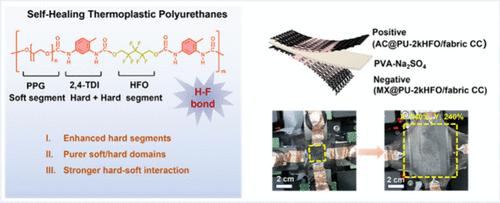新型热塑性聚氨酯使双轴可拉伸导体的超级电容器具有高面积电容
IF 9.1
1区 材料科学
Q1 CHEMISTRY, MULTIDISCIPLINARY
引用次数: 0
摘要
可拉伸超级电容器因其低发热量和无缝集成能力而成为可穿戴电子产品的重要组件。热塑性聚氨酯弹性体以其动态氢键结构而闻名,具有出色的拉伸性,非常适合这些应用。本研究在热塑性聚氨酯的硬段中引入了氟基相互作用,从而使聚氨酯具有低弹性模量、高断裂强度、优异的抗疲劳性和自愈性能。通过使用这些聚氨酯作为粘合剂和网状织物作为支架,我们开发了高度可拉伸的导体。这些导体在双向拉伸下保持低电阻(~ 26欧姆),并在1600次拉伸循环后表现出稳定的双向导电性。制造的超级电容器电极,结合织物集流器,聚氨酯和MXene,实现了7200 mF cm-2的超高面比电容,并在2300次循环后保持100%的容量。这种材料设计策略为可穿戴电子产品的弹性材料、可拉伸导体和高性能能量存储提供了巨大的潜力。本文章由计算机程序翻译,如有差异,请以英文原文为准。

Novel Thermoplastic Polyurethanes Enable Biaxially Stretchable Conductor for Supercapacitors with High Areal Capacitance
Stretchable supercapacitors are essential components in wearable electronics due to their low heat generation and seamless integration capabilities. Thermoplastic polyurethane elastomers, recognized for their dynamic hydrogen-bonding structure, exhibit excellent stretchability, making them well-suited for these applications. This study introduces fluorine-based interactions in the hard segments of thermoplastic polyurethanes, resulting in polyurethanes with a low elastic modulus, high fracture strength, exceptional fatigue resistance, and self-healing properties. By utilizing these polyurethanes as binders and meshed fabric as scaffolds, we developed highly stretchable conductors. These conductors maintain low resistance (∼26 ohms) under biaxial stretching and exhibit a stable bidirectional conductivity after 1600 stretching cycles. The fabricated supercapacitor electrode, incorporating fabric current collectors, polyurethane, and MXene, achieves an ultrahigh areal specific capacitance of 7200 mF cm–2 and retains 100% capacity after 2300 cycles. This material design strategy offers significant potential in elastic materials, stretchable conductors, and high-performance energy storage for wearable electronics.
求助全文
通过发布文献求助,成功后即可免费获取论文全文。
去求助
来源期刊

Nano Letters
工程技术-材料科学:综合
CiteScore
16.80
自引率
2.80%
发文量
1182
审稿时长
1.4 months
期刊介绍:
Nano Letters serves as a dynamic platform for promptly disseminating original results in fundamental, applied, and emerging research across all facets of nanoscience and nanotechnology. A pivotal criterion for inclusion within Nano Letters is the convergence of at least two different areas or disciplines, ensuring a rich interdisciplinary scope. The journal is dedicated to fostering exploration in diverse areas, including:
- Experimental and theoretical findings on physical, chemical, and biological phenomena at the nanoscale
- Synthesis, characterization, and processing of organic, inorganic, polymer, and hybrid nanomaterials through physical, chemical, and biological methodologies
- Modeling and simulation of synthetic, assembly, and interaction processes
- Realization of integrated nanostructures and nano-engineered devices exhibiting advanced performance
- Applications of nanoscale materials in living and environmental systems
Nano Letters is committed to advancing and showcasing groundbreaking research that intersects various domains, fostering innovation and collaboration in the ever-evolving field of nanoscience and nanotechnology.
 求助内容:
求助内容: 应助结果提醒方式:
应助结果提醒方式:


